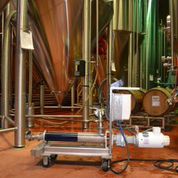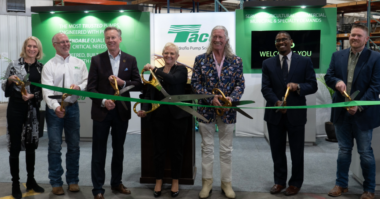The first Goose Island Brewery opened its doors on Friday, May 13, 1988 in Chicago, Illinois with an aim to deliver to the United States a diverse selection of uniquely crafted beers much like the ales and lagers one might find in Europe. Home to a large and diverse population, Chicago proved to be an excellent location to test the public’s modest palates in a time when America was drowning in mass-produced domestic beer. By 1995, a larger brewery and bottling plant was opened on Fulton Street in response to rapidly growing interest. With more room for growth in 1999, a second Goose Island brewery was opened near historic Wrigleyville.
Goose Island’s beer recipes are primarily made from four natural ingredients; malted grain, hops, yeast, and water. The brewery is divided into a “hot-side” and a “cold-side” with distinct sections, each reserved for one part of the brewing process. The work in the brewery is divided into 9 steps: Malting, Milling, Mashing, Lautering, Boiling, Fermenting, Conditioning, Filtering, and Filling. The 1,500 square foot brew-house (hot-side) is responsible for mixing malt, hops, and water and the 10,000 square foot refrigerated cellar (cold-side) is where the beer is finished and bottled.
As grapes are to wine, malt is to beer. Malt begins as germinated grains (commonly barley, less commonly, wheat or rye) that have been soaked in water and then dried with hot air in order to stop germination. Next the grains are passed through a mill and ground into a powdery substance called grist. The grist is then mixed with warm water (known as liquor) in a large vessel called a “mash-tun”. The resulting substance is now referred to as Mash, which is sent to another vessel called a “lauter-tun” where enzymes break complex carbohydrates into fermentable sugars. The sugars dissolve in the surrounding liquor to form sweet wort. The sweet wort is boiled in a kettle for sterilization and to ensure the right sugar content. During the boil, hops are added for flavor and bittering. Hops also act as a natural preservative. The wort, now referred to as bitter wort, is sent to a whirlpool for another hop addition and to remove any residue from boiling. Now it is cooled from about 210 degrees F to about 70 degrees F and aerated as it is sent to a fermenter to be mixed with yeast.
Yeast is largely responsible for the variety of flavor in beer and arguably the most important ingredient in the brewing process. It helps in the metabolic processes that produce ethanol (alcohol) and carbon dioxide (bubbles and foam). Once yeast is added, fermentation begins immediately as the yeast consumes the sugar source in the wort. Some of the brew containing the matured yeast recipe is collected and saved for subsequent brews. After a period in the fermentation vessel, the beer is ready to go into tanks where it is further carbonated, filtered, and finally packaged in bottles or kegs for distribution. Out of literally hundreds of varieties, Goose Island utilizes over 20 different strains of yeast in perfecting their recipes. On any given day, the brewery transfers up to four yeast strains to a fermenter.
The problem:
During the brewing process, safely delivering “viable yeast” on a daily basis is extremely important. The recipe is compromised if the yeast isn’t handled properly. At one time a rotary lobe pump was used for yeast transfer. A lobe pump is one type of positive displacement pump where the rotation of the gears produces a partial vacuum to draw the liquid into the pump. The liquid is carried between each lobe and the casing to the opposite side of the pump. The meshing of the lobes forces the liquid to the discharge. The direction of pump rotation determines which of the nozzles will be the inlet and the outlet. If rotation is reversed, the nozzle functions in reverse and the pump is able to pump backwards. However, lobe pumps typically perform better with low pressure flows, and in this application where flow control is very important, the lobe pumps were unable to maintain suction and struggled with bi-directional flow. Additional control valves were required to keep the lobe pumps running properly. The Solution: For yeast transfer from tank to tank, the brewery on Fulton Street trusts a SEEPEX food grade BCSO 10-6L progressive cavity (pc) pump, conveniently mounted on a rolling cart for easy mobility. The pump transfers a calculated amount of yeast into an empty fermenter where the fermentation process takes place. In a progressive cavity pump, a single helix rotor turns insides a double helix stator to create cavities which progress from the suction to discharge to create flow. The compression fit between the rotor and the stator creates seal lines that keep the cavities separate as they move through the pump with each rotation.
The Benefit:
The result is flow with very little pulsation and low shear rates. This type of pump is particularly well suited to the brewery’s application due to its valveless design. The pc pump is actually a pump and control valve in one and can pull yeast flow in both directions without the need for extra equipment like valves. The pc pump solved a multitude of flow control issues other pumps that need control valves have. There is no worrying about closed valves, open by-pass valves, internal or external air leaks, or obstructions in the suction or discharge pipework. The brewery could choose from a wide range of sealing options for their SEEPEX pump, whereas they were once limited to mechanical packing. Brian Taylor, Goose Island’s Head Cellerman, responsible for overseeing fermentation and filtration processes said, “I can tell you that a good yeast pump needs to deliver an exact amount of yeast for fermentations to stay on track. We added a flow meter to the pump as well. Our cellarman can set the gallons specified, walk away, and know the pump will shut off once that number is reached. That is not the case with other pumps.” Additionally, the pc pump is CIP and SIP-able and also meets 3-A standards. Cleaning and sanitation of the brewery and its components is taken into consideration at every phase of the beer brewing process. Sanitation prevents microbial growth on the brewery equipment. Taylor said, “Since the pump is multi-directional, we are able to sanitize our lines with acid going forward. Once we have sanitized our hoses and SEEPEX pump, we change directions, open our pitching fermenter, and start the pump in reverse. Once we have reached our calculated pitch volume, the pitching tank is closed. Hot water and chemical is then sent through the pump in forward position. Obviously, this is a great component for a brewery. We can now sanitize without disconnecting hoses or risking infection. We needed a pump that can easily feed in both directions and the SEEPEX pump answers that need.”
Today, Goose Island brews an impressive selection of over 50 craft beers which are enjoyed in all 50 states and Europe. Production literally never stops. Goose Island runs 24 hours a day, 7 days a week. The emergence of craft brewers like Goose Island Beer Company and American consumers’ newfound appreciation for quality beer has resulted in what is often called the “Craft Beer Renaissance.” Goose Island’s renaissance success is evident due to its many awards and the popularity of their brewpub restaurants located in Lincoln Park and Wrigleyville. They are open for lunch and dinner and are give daily tours of their facilities that happily end in beer tasting.





Comments